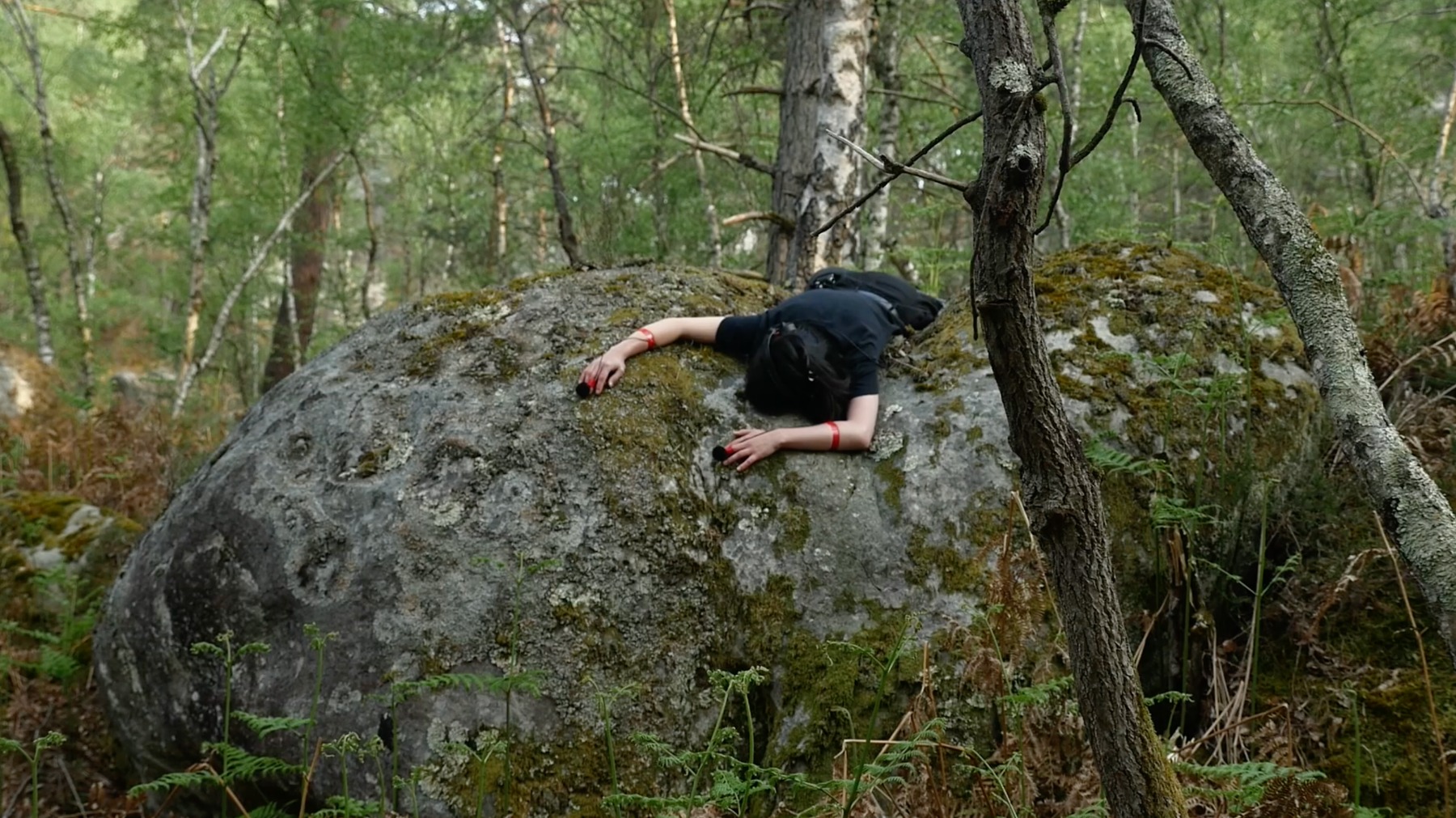
Embracing the World to Hear It
A Conversation with Morten Søndergaard, Curator of the Nordic Biennale of Contemporary Art MOMENTUM 13
The Nordic Biennale of Contemporary Art MOMENTUM opened this June for the 13th time. The biennale was founded in 1998 in the Norwegian town of Moss, which is located in the very heart of the Nordic region – on Norwegian territory, yet equidistant (about an hour’s drive) from both Oslo and the Swedish city of Gothenburg. With a population of 50,000, Moss is perfectly embedded in the landscape of a sea fjord and sharply reflects the themes of post-industrial civilization, gentrification, and glocality.
“Since its eleventh edition, most venues and sites are located on the island of Jeløya, offering an opportunity for MOMENTUM to engage in a closer relationship with nature, explore the connections of different landscapes to local cultural history, and be a catalyst for change,” reads the biennale’s website. The forest, the stones, the moss, and the calm summer sea tune one into a different mode of perception. It is on this very island that the elegant white building of Galleri F 15 is located, an art institution founded in 1966, which has become the center and heart of the biennale, its organizer and producer.
For over two decades, MOMENTUM has consistently supported compelling curatorial vision and operated as a platform for exploring the exhibition format, both in the Nordic context and with an international perspective. In the previous edition of the biennale, for example, the very idea of curatorial authorship as an individual creative vision was reconsidered, and the biennale was shaped as a chain of collective interactions initiated by the Norwegian Tenthaus Art Collective. The 13th edition of the biennale, however, has returned to the concept of the individual curator. This time, that role is taken on by Morten Søndergaard, an internationally acclaimed sound art curator and professor of sound and media art at Aalborg University in Denmark.
The revolutionary and unexpected quality of this edition lies less in its structure and more in its chosen medium. The 13th edition of the MOMENTUM Biennale (Between/Worlds: Resonant Ecologies) is an exploration and celebration of sound. It invites audiences on an extraordinary journey through soundscapes and stories that traverse the boundaries between human and non-human worlds. Its core message is, perhaps, a call to listen to the world – a shift away from broadcasting endless statements and opinions toward an attentive, receptive posture. What if we stopped speaking and instead tried to hear what the world is murmuring, singing, or chirping back to us?
Mélia Roger (France). Intimacy of lichens / Intimacy of stones, 2021. 2 channels video installation. Through tactile microphones attached directly to her hands, Roger amplifies the otherwise imperceptible vibrations encountered when she delicately interacts with lichens, stones, and natural surfaces. This amplified contact reveals hidden sonic ecologies that are normally inaudible, cultivating what Roger terms ‘eco-empathic listening
This idea is most directly expressed in the works of French artist Mélia Roger, a field recordist and artist committed to fostering ecological awareness through environmental and empathetic listening. In her video Intimacy of Stones (2021), she embraces a giant stone with her arms, to which several small microphones are attached. Through this motionless embrace, we are invited to hear the inner soundscape of this singular, self-contained world. Through touch, we are given the chance to truly listen. It is a simple yet deeply sincere and layered metaphor: to embrace the world in order to hear it.
But many of the other works – out of the forty projects presented here – also explore sound in its many forms: from the tiniest inner worlds to the vastness of outer space. Curator Morten Søndergaard has long been engaged with the field of sound art. So here we also encounter several quite “classic” pieces, such as Breath (1995) by Daniel Pflumm. This Swiss-German artist turned his attention to the subtle phenomenon of the breath that news presenters take just before reading out yet another shocking headline. The video is an endless, looped montage of such inhales – a single, collective gasp, an attempt to take in enough oxygen to withstand what comes next. Or take the work by Latvian-Estonian born sound artist Kalle Aldis Laar, Calling the Glacier (2007): a direct telephone line to the Vernagt Ferner glacier. A microphone installed on-site transmits the live, unedited sounds of the melting ice directly to anyone who calls the number. In a small booth nearby, you’ll find business cards printed with the project’s phone number. Call it – and you will hear the world melting. The world as we knew it?
To learn more about the concept behind the biennale – and how the contemporary art world’s attention toward sound art is evolving, along with sound art itself – we sat down for a conversation with Morten Søndergaard on the terrace of the café at Galleri F 15. On the recording, you can hear birds singing and the soft murmur of conversations from nearby tables.
Morten Søndergaard at the opening of the Momentum 13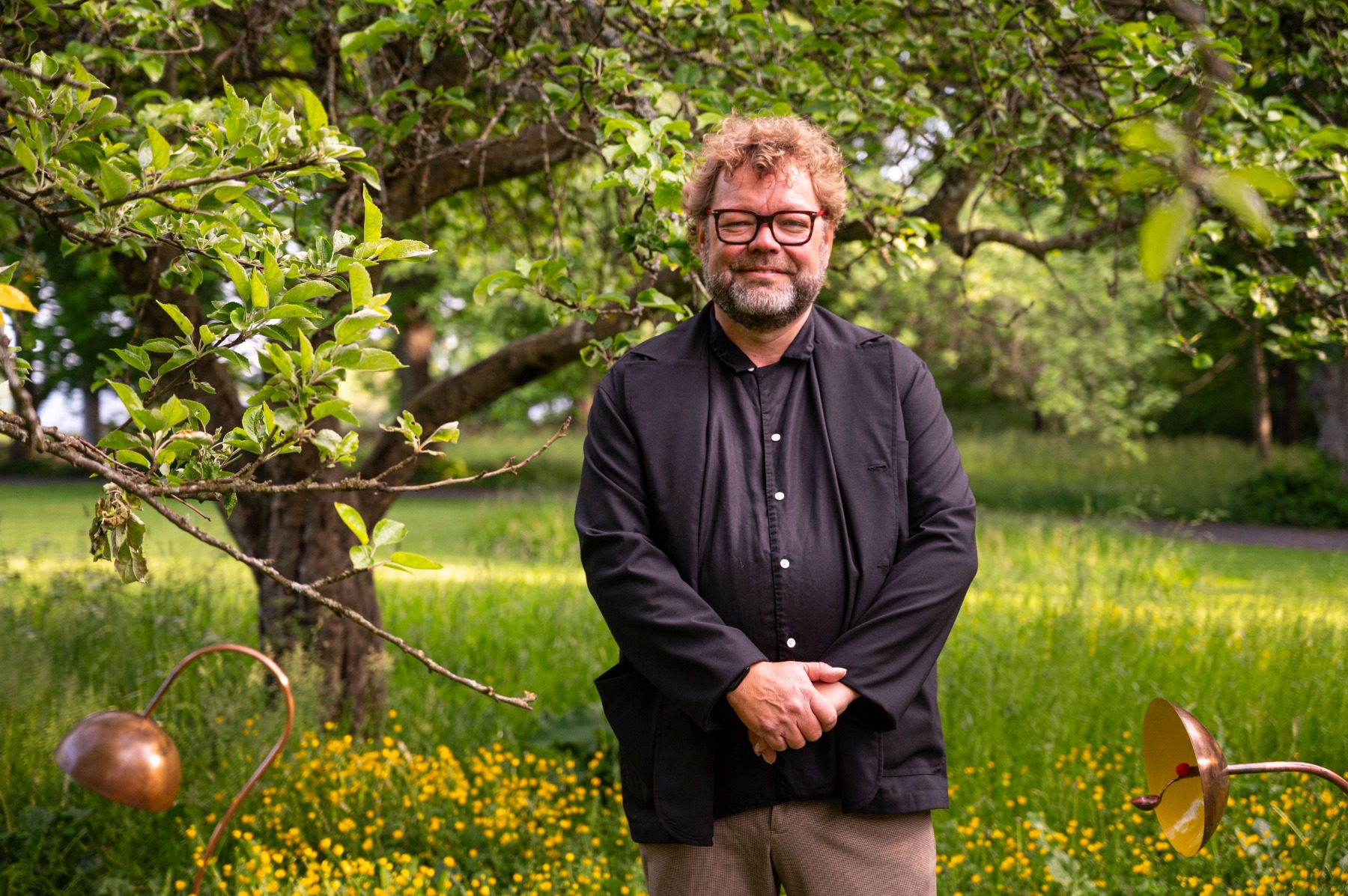
Right now, the sound dimension is increasingly coming into focus, as we're beginning to understand that it's actually another kind of space. We're quite used to paying attention to physical space and distances. But sound used to be like a kind of liquid, floating around us—something we perceived without truly reflecting on it as a distinct field or discipline, unless it was rhythmically organized into music. Now, we're paying more and more attention to it. You've been in this field for quite a long time. Does it feel like a new era for sound art?
That's a good question. I think sound art has always been – at least for me, when I discovered it around 1996–97 – both an inspirational and a clearly influential force in the development of 20th-century art. When you look back at what has been done with sound, you realize it's everywhere. It's something that almost all visual artists have been curious about at some point. But it has always existed more as a subcurrent. When I started working with sound archives in 1999, nobody in the art world wanted to deal with that. And it wasn’t even that long ago. I was told there was no category for it.
So, the simple answer to your question is: yes, it has changed. Sound is becoming more central to the way art is developing. At the same time, I think there's also an interesting, somewhat divergent tendency. You can see sound being integrated into contemporary art in various ways – as more of a medium of experience. In my understanding, it's not something that necessarily engages with the central core of aesthetics. And that's one trajectory.
The other trajectory is where artists are truly using sound – and the technologies of sound – as a genuine aesthetic foundation. You could even say they’re working with the physics of sound, exploring spaces where images and meaning emerge directly from sonic processes. So, it’s not just an exploration of sound itself, but also of many other concepts through this medium and its physical properties. I find that deeply fascinating. Over the past ten years, this direction has become especially strong. There's a new generation emerging now, producing amazing work and really engaging with this field in exciting ways.
And that’s not only really nice to see – it’s also, I think, an inner necessity for the art world, to avoid repeating itself too much. I find there's a lot of repetition in contemporary art. Sometimes you visit exhibitions in London, Paris, Norway, or Denmark, and you see almost the same things. Sometimes it’s even the same artists showing in multiple places within the same year. So, there’s not just a lack of curiosity, but maybe also a lack of willingness from institutions to truly engage with more experimental work. What we now call 'contemporary experimental' was cutting-edge in its time – and still is, to some extent – but if you repeat the same experiment 20 years later, maybe it’s not so experimental anymore. Then it becomes something else, right?
And I think sound is excellent at disrupting habitual ideas of what art is. What’s amazing is that it continues to do so – it hasn’t settled into a kind of safe, familiar aesthetic that people can just consume comfortably.
Louise Mackenzie (UK). Attractor, 2025. Listening score, sculptural parabolic microphones, live-streamed audio, live performance. Louise Mackenzie uses custom-designed parabolic microphones to collect the sounds of insects at Galleri F 15, broadcasting their sounds via radio to Moss Church. Audiences are invited to reflect peacefully on our environmental relationship through the sounds in the work, which also form the basis of a live choral performance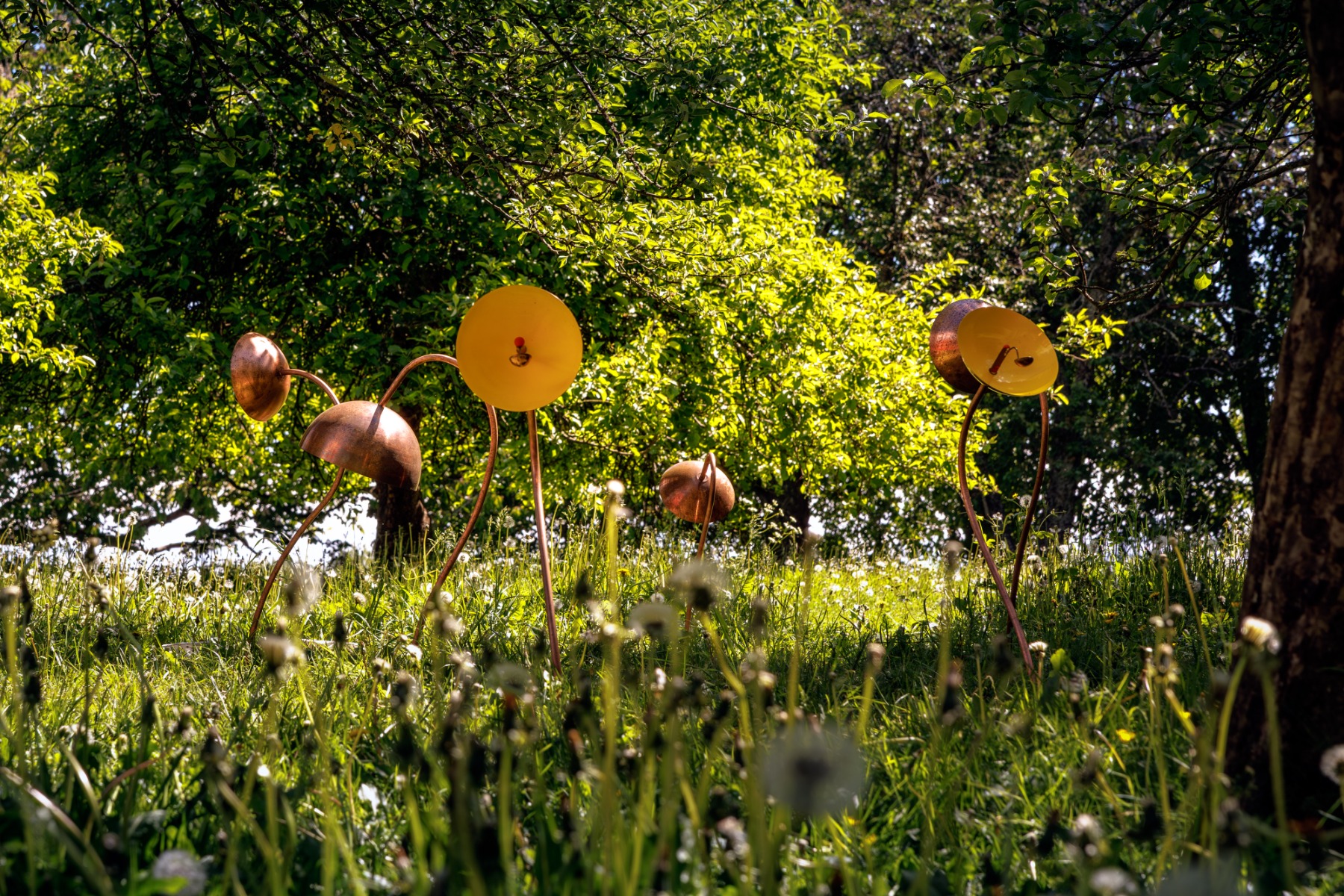
It’s the “new thing” ...
It still feels new, but also something that isn’t easy to deal with. We can’t close our ears; sound goes straight into the subconscious. It touches layers we may not want to address. It activates subcurrents, and that will always challenge an audience.
In this way, I think sound is uniquely powerful in encouraging people to explore themselves and to experience art differently. And of course, for an artist, it’s an incredible medium – an excellent specialty, even. It opens up a whole new space for aesthetic exploration. But actually, what’s most interesting is that we share this experience with the artist. We all listen. We all have language. We all experience sound as a common denominator. Whereas visuality can sometimes become a bit more abstract. Do we really share these visuals? Do we share these metaphors, these symbols? We might interpret them very differently – and that’s fine, we call it freedom of interpretation.
But with sound, it’s different. It surrounds us. We hear more or less the same things as the artists. We share that sonic world with them.
Christian Boltanski (France). Misterios, 2017. 3 screen projection, sound, color; 12 hrs. Dimensions variable. Edition of 3. The video triptych Misterios (Mysteries) documents a project made on the rocky, uninhabited coast of Bahia Bustamante in Patagonia. Three colossal trumpets, mounted on the shore, produce a sound reminiscent of whale song as strong ocean winds pass through them
So, are sound art pieces more strictly interpreted?
No, I actually think they open up more. Interpretation is interesting – because it needs some kind of base, but it's also something we’re constantly doing.
With visual art, we tend to interpret automatically. That’s what the news does, too – it communicates with images in ways that often manipulate our emotions. But sound engages our interpretive faculties in a completely different way. It taps into the pre-semantic layers of understanding – before meaning even arises. But it also exists after meaning, and in between. It’s all there, at once.
Whereas, in a way, the visual field often feels like the endpoint of a tunnel of interpretation – one that the artist, to some extent, has already traveled for us by composing the image. A sonic composition remains more open. I would say that it invites interpretation in a different way. It allows us to realize that meaning is something developed by us, but together with others. In that sense, it’s intersubjective – and even, I’d say, interobjective.
Sound art quite often is using a language...
And also pre-language, and also all foundational elements of what language is. Which, in itself, is a miracle, isn’t it? The fact that we can communicate using our skeletons, our ears – is extraordinary.
Carl Michael von Hausswolff (Sweden). Electronic Voice Phenomena: The Lady in Yellow – “Look At Me … You’re Gone”, 2025. Audiovisual installation. Layering static, spectral murmurs, and barely audible creaks, it conjures a sonic conversation between the present and the unknown. In this charged atmosphere, moments of recognition slip away just as they surface, mirroring the estate’s whispered mythology
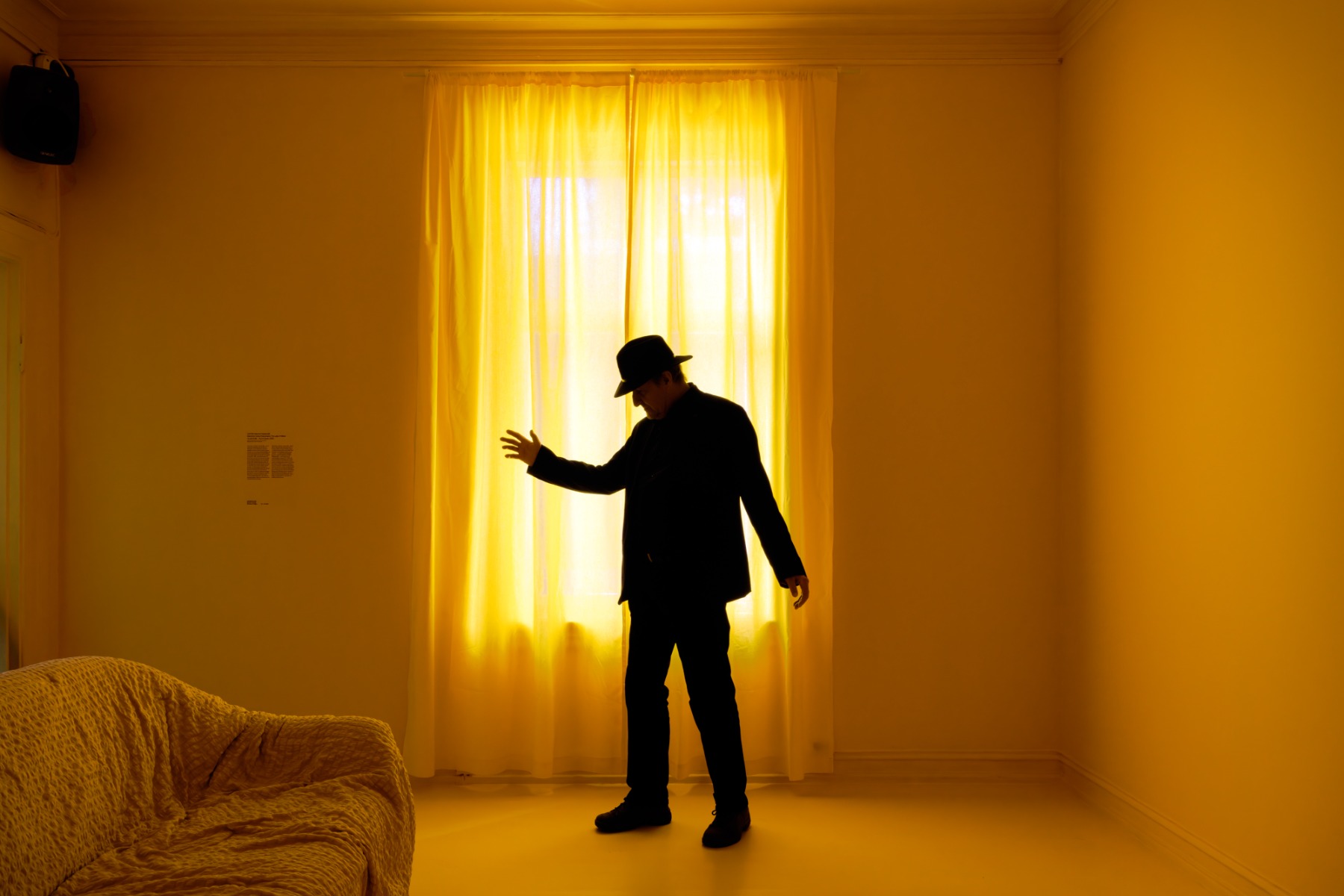
But voices that appear on their own – without the visible bodies that produce them – have always been seen as something mystical, like voices from the forest. And in the exhibition Momentum 13, there's a work that addresses this directly, interpreting stories about the huldrefolk – mythical beings with magical abilities and a deep connection to nature. This is Skog og li og bekker forbi (Forests and Hills and Streams Passed) by Frank Ekeberg.
There’s also an audiovisual installation by Carl Michael von Hausswolff, Electronic Voice Phenomena: The Lady in Yellow – “Look At Me … You’re Gone”, which taps into that same imaginary space – what sound creates inside our minds.
But ghosts – what are they, really? Of course, they are part of our imagination, but they are also shaped by how we communicate – and by the technologies we invent to do so. In that sense, all these invisible or inaudible elements explored in the exhibition are part of the artists’ curiosity. They’re playing with liminalities and the shifting boundaries of meaning.
When do we say that something has meaning? Where is the boundary of what we can truly know? Right now, we’re sitting next to μ, the sound installation by Christian Skjødt Hasselstrøm. Cosmic rays – high-energy particles originating from space – constantly bombard the Earth. While most are blocked by the atmosphere, a few penetrate and create showers of secondary particles, including muons, that reach the surface. This invisible shower forms a continuous flow that surrounds and bathes us and our environment. The artwork uses advanced experimental particle detection technology, and in that sense, it functions as a live cosmic listening station.
There’s something ghostly about this energy – transmitted through the vastness of the universe and arriving here in a quiet, almost celestial way. It’s a reminder that even what we can’t see or hear directly still shapes our reality, and sound becomes a bridge between what is known and what is just out of reach.
Christian Skjødt Hasselstrøm (Denmark). μ. 2022/2025. On the front lawn outside Galleri F 15, 120 brass hemispheres form a meticulous grid. From within each, traces of distant cosmic events surface —directly detected and subtly amplified. The artwork uses advanced experimental particle detector technology to extend and explore human sensory and cognitive capacities, conducting a sensory exploration of a ubiquitous cosmic phenomenon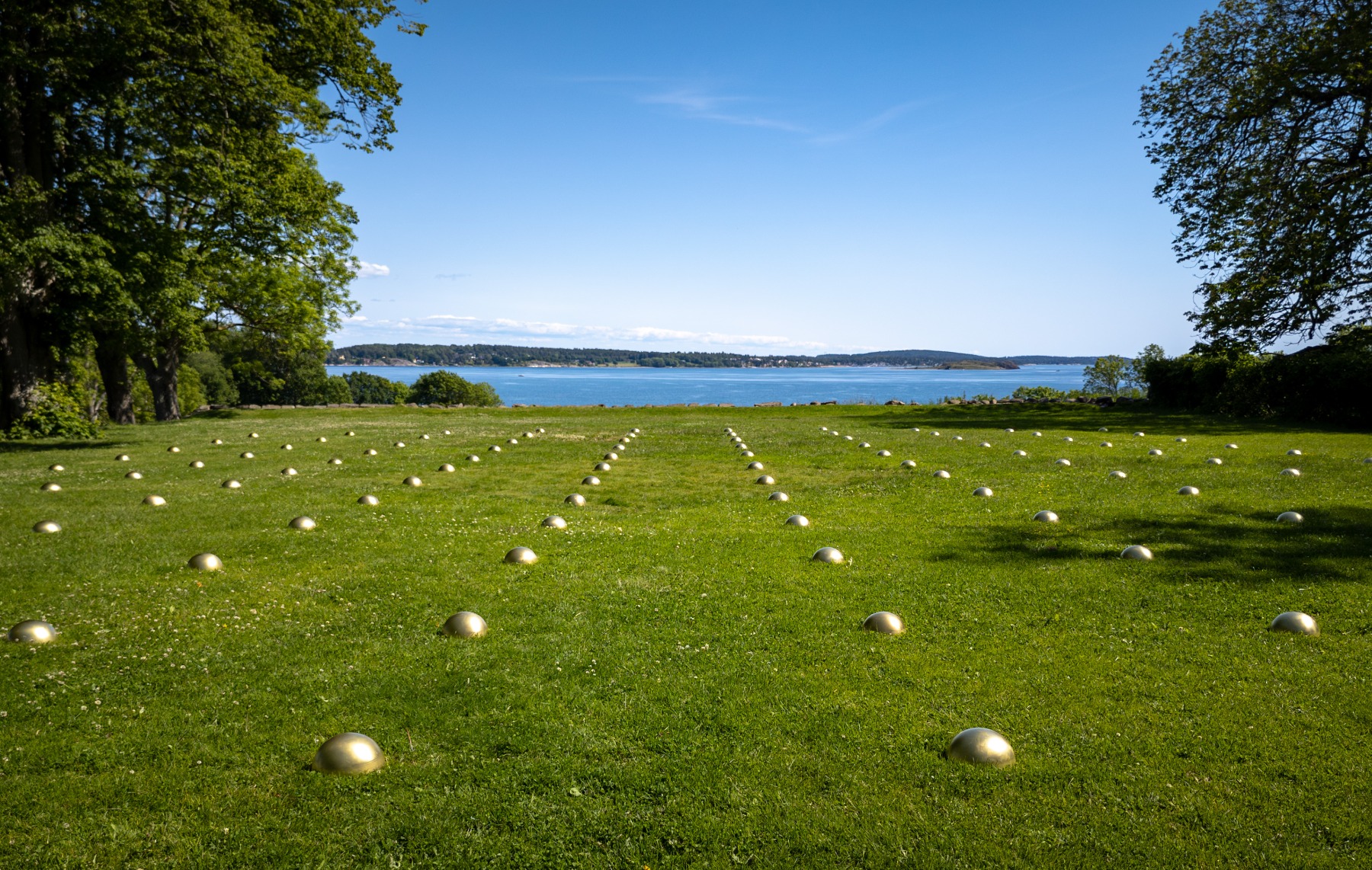
We hear the sound of the energy falling from cosmos...
Yes, they are energy particles. And they move through the universe and then hit the Earth here. More precisely, these cosmic rays interact specifically with the atmospheres and surfaces of planetary or lunar bodies, creating secondary particle showers that reach the surface. They actually hit any celestial body in the universe. And this energy is transported by the artist into this clicking sound, which is actually more like a reaction to the energy that we hear. And since these particles are passing through our brains and our bodies constantly, and we share that as well, that's just, you know, mind-blowing to think about. But it's not something we can understand. It's not part of the meaning of anything. It's not part of, you know, a culture. It's something completely outside what we call culture and language.
Natasha Barrett (United Kingdom / Norway). Talking Trees: A Nature-Responsive Grove, 2025. This sound installation captures sounds created by wind and nearby voices in the Alby forest and its shoreline, to create a real-time composition. Enhanced natural sounds reveal often-overlooked qualities: swaying trees, creaking branches, falling rain, and distant tidal rhythms. These subtle, often unheard elements blend with the existing soundscape, acknowledging visitors who wish to become part of the system
Galleri F15 and the surrounding areas are nestled in the forest, and it's a place full of life – especially birds. As I understand it, there was a process of integrating the sound works into this natural landscape, during which you consulted with local specialists and biologists. How difficult was the process of creating this “sound network” for the biennale?
Well, actually, it was quite easy in a way – because when I first arrived here, I walked from Moss Hotel up to Galleri F15. And during that walk, the idea just came to me. It was right in front of me: these different worlds.
I walked from Moss, which is very post-industrial. And I don't think anyone would disagree if I said it's still struggling to become a real city. It's kind of ugly in parts, but also has some historic charm – though it's very mixed. It’s a fragmented city, like a lot of Norwegian towns from the past 80 years.
But quite quickly, as I moved into Jeløya island, it turned into a completely different kind of landscape. There’s this natural forest here that hasn’t been managed – intentionally, because they wanted it to remain in its original state, in a way. Every tree that falls is left where it is. That’s a human decision, of course – a cultural idea: that the forest is somehow better, or more authentic, when it's left to take care of itself. Then I arrived here, at Galleri F15 – a very curated, kept kind of place. A garden, a gallery, a world of its own, where people come to have coffee, eat cake, and maybe talk about whatever life has brought their way.
I found these contrasting worlds really fascinating – so the idea came quite naturally from that. Not in a concrete form at first, but more as a feeling, a concept of maybe five distinct 'worlds' coexisting. Especially when I discovered that this is a volcanic island, that there’s an alder forest here, and the Oslo Fjord nearby – it felt only natural to begin a conversation with these landscapes. So really, it all came from here. In that sense, it was a gift to me.
And is the title of the biennale – Between/Worlds: Resonant Ecologies – also connected to this idea of zoning or these different ‘worlds’ you mentioned?
I worked with Peter Weibel, an Austrian post-conceptual artist, curator, and new media theoretician. And the last project we did together was a conference in 2017 called Resonant World. The title is inspired by the physicist Hans Christian Ørsted, whose main scientific contribution was the discovery of electromagnetism (1820). Ørsted also explored and extended acoustic principles developed by earlier scientists, such as Ernst Chladni. Ørsted struggled to name what he had found, because it was something that wasn't quite visible, yet somehow was. It wasn’t purely physical, yet it was physical. It behaved both like a wave and a particle. In his search for the right language, Ørsted spoke with his friend Hans Christian Andersen, the author and poet. Andersen’s proposal was to call it 'Resonant World'. That idea – of hidden qualities in both people and things, the capacity to send something out into the world, to affect it in unseen ways – it's deeply present in Andersen's fairy tales. That metaphor of resonance stayed with me. So I sort of combined that into the title as well.
Quite early on I reached out to a number of artists, and they came here to explore the site. There was no predefined plan – no decisions like, 'Christian, you're going here,' or 'Louise, you're going there.' It was all developed through dialogue and conversation: what each artist wanted to do, and where it might belong. Of course, there were some practical challenges. We couldn’t bring power to every corner of the island, so that became our main limitation – which, in a way, turned out to be a good one. It forced us to work more intentionally, collecting as many works as we could within the reach of electrical power.
And of course, we were very careful not to disturb the natural environment here, because the area has a rich bird and animal life. So we consulted with a biologist and the city officials in Moss. We sent them all the relevant files and asked: 'Is this a problem? Let us know, and we’ll make adjustments if necessary.' We did this quite early in the process. It was also essential for obtaining permits, since it's public forest. They needed to hear that the project wouldn’t disrupt the natural ecologies – and that was something we took seriously from the beginning.
Stephanie Loveless (Canada). Spisslønn / Norway Maple, 2025. Three metal horn speakers resonate with vocal compositions created through slow, attentive listening to a single Norway maple tree near the artist’s home in upstate New York. The composition is shared as an offering to the Norway maple trees near the MOMENTUM exhibition site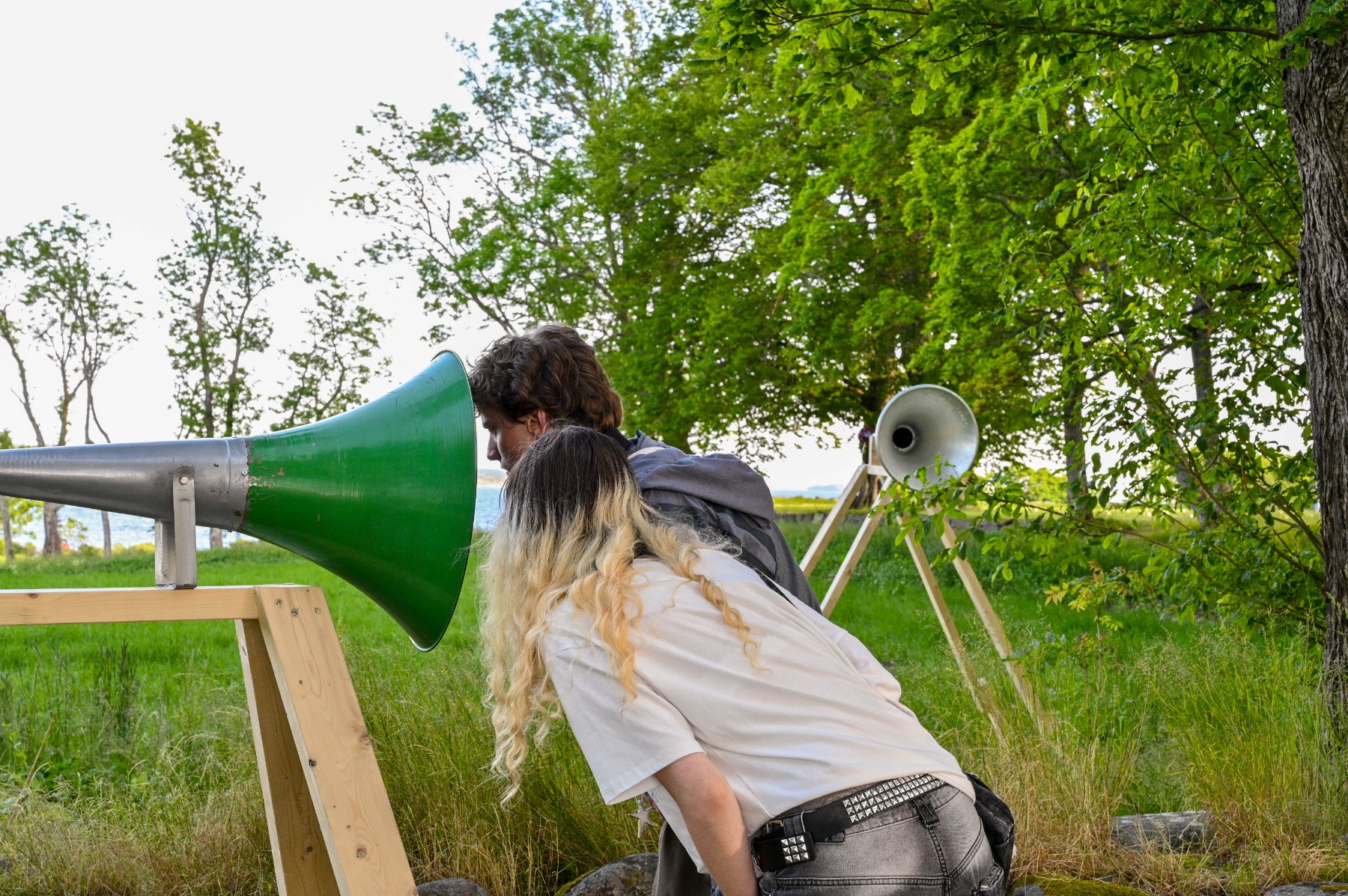
I also really love some of the terminology you use in the Momentum 13 catalogue. There are some beautiful word combinations – for example, acoustic justice. Could you elaborate on that idea a bit more?
The term acoustic justice is, of course, a concept developed by Brandon LaBelle. For example, Luz María Sánchez’s installation at Momentum 13 explicitly engages with acoustic justice by addressing the political dimensions of listening – highlighting the voices and silences around the terrifying phenomenon of forced disappearances in Mexico. I’ve also written a bit myself about the idea of the ‘citizen of the sonic artwork’ ç how we exist together through sound and through ‘unprepared listening’. Acoustic justice brings attention to the many differences in our abilities and freedoms when it comes to listening. Even the very freedom to listen varies greatly across the world. There’s something deeply political in that – the fact that in different parts of the world, people have different capacities to listen, and just as importantly, to be listened to.
So, you can almost detect the level of social or political injustice in a culture through how listening operates – through who gets heard and who doesn’t. It becomes a way to measure not just freedom, but the ability to enact freedom. For instance, Mexico is very different from Norway in this regard – even if this comparison may serve only as an illustrative example rather than a comprehensive analysis, acknowledging the complexity and diversity within each country's social and political contexts. There’s a powerful installation in the biennale by Luz María Sánches that addresses the terrifying reality of women – and also young men – being abducted and killed randomly, or it seems random. And increasingly, in certain regions, simply raising your voice as a woman puts you at risk.
There are these limitations – and an increasingly narrow space – for the kinds of freedoms we often take for granted. Not just freedom of speech, but the basic ability to move through the world safely and freely. In Mexico, for example, it’s much more limited compared to here. But I also think that could change here too, if we don’t pay attention. Maybe Mexico always have been a bit of the wild place in this case, but what I hear, also from Luz – is that over the past decade or more, that space has become even narrower. There’s something happening in the structure of that society that signals a deeper problem. Of course, there is criminality, and then there are the drug cartels – and the fact that the U.S., right next door, is driving demand for those drugs. So there are these capitalist, criminal economies that are supporting this narrowing of the free space.
So I think that here, too, sound can be used almost like a kind of sonar – to register the limits of freedom. Because freedom itself is such a complex concept – philosophical, hard to define in just one sentence – but we might at least begin by attending to its boundaries. And I believe that’s already a meaningful place to start, since those limitations are very real.
Luz María Sánchez. Vis.[un]necessary force_4, 2019. Participatory sound installation. This multi-channel sound installation addresses enforced disappearance in Mexico and the work of Las Rastreadoras de El Fuerte, a collective of women searching for clandestine graves in the northwest Mexico desert. Despite threats, their actions continue amidst an unresolved humanitarian crisis

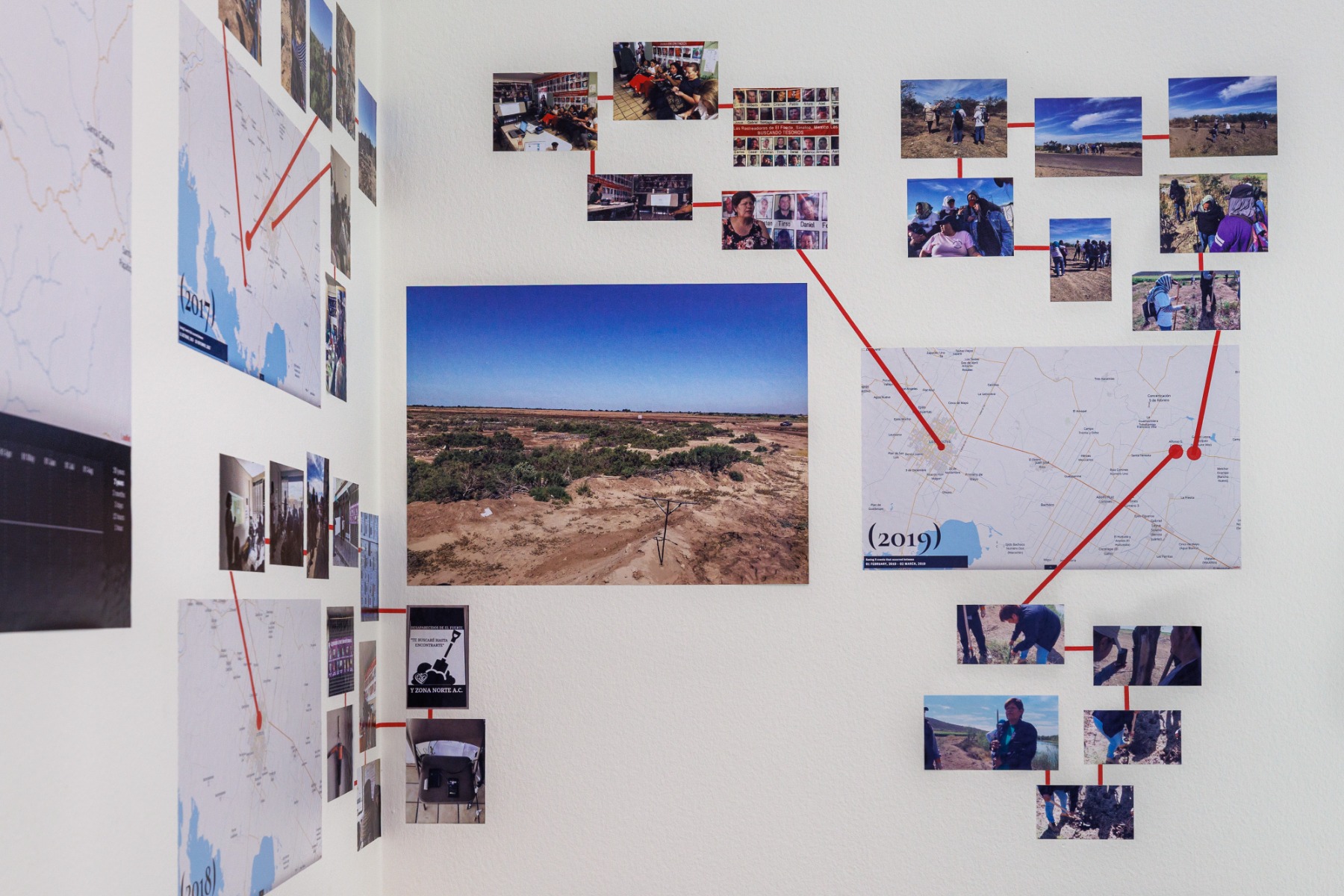
You've been involved in sound art for quite a long time now – you’ve helped shape its core, and now you’re also helping to distribute and expand it. How do you see sound art developing in the future? Are there any new territories that you think could become particularly interesting?
Actually, I was thinking the other day on the post-imperialist landscapes of former Eastern Europe. I visited Prague in 1984, and then East Berlin. I remember people handing me tapes – sharing sound material, underground. And I also had experienced my first interactive sound guided tour at the Pergamon Museum in East Berlin.
So, there is already a history there, a memory of experimentation in those regions. And I would definitely include the Baltic area in this as well. There’s something I think we’ve never really addressed properly – the post-imperialist, post-Soviet landscape. What was left behind, and what happened after the 1990s? At least I feel I personally failed to really look into that for a long time. But now, having many friends in that region, I’m realizing just how rich – and at the same time, deeply problematic – it is. There’s a lot there: pain, layered aesthetics, and a great deal of compelling art. That in itself could be a major focus – actually, I think it could support several biennials, from Montenegro to the Baltics.
The other region I've been thinking about is the Arctic – what I call the Arctic arena. It tends to get divided up into different indigenous territories: the Sámi, the Inuit, living in Russia, Canada, Greenland, and beyond. But maybe we need to look at it as a shared, interconnected whole – an environment and a region that all of us are part of, one way or another. And to explore that space through sound could open up something really profound.
But how might sound art evolve as a medium?
As for sound art itself – where it might go – well, I think it’s already evolving in a more attentive, deeply listening direction. But what I would really like to see, and I don’t know if it will happen, is that sound art becomes more political. Which is something that underlies both of these directions I’ve mentioned. The sonic medium has a unique ability to register power structures, trauma, resistance, and presence in ways that images or text sometimes can’t. And I think that’s worth pushing further.
But maybe what I’m also proposing is that we take sound art more deeply into the worlds it already touches – just in more political ways. For instance, asking: how do we actually become citizens of something? How do we grow up democratically – if that even matters anymore, and if so, in what ways?
At the same time, I believe there’s still enormous potential in the perceptual dimension – in exploring how we perceive, and how sound reshapes or destabilizes that. There’s still a lot more to do there. And then there's science. There's been a lot of talk about “art and science,” but specifically sound art and science – now that’s a space I believe is incredibly promising, and still largely underexplored. It’s been touched on, of course – it’s not new – but I think there’s a lot more that could be done at that intersection. There’s real potential there for deeper inquiry and for unexpected forms of artistic creation.
